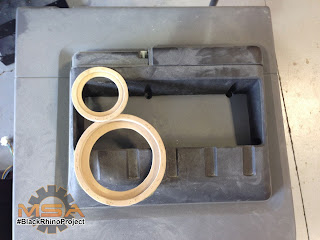MSA's 2013 SEMA Project: Black Rhino > Headlamp Retrofit

As with most everything, this wasn't an easy task to accomplish. Most headlamps these days are situated in such a way that disassembling them makes it difficult. There are several ways to go about separating the headlamp lenses, every single one of them softens the glue. One way is the oven. This is risky because the lenses are plastic and can melt under the heat. Second is using a heat gun. The challenge here is the black housing itself can melt under the heat gun should you keep it in one spot too long. The last way I've been told is putting the headlamp in some very very hot water.
My option was the heat gun. I didn't have a stove here at the shop to boil hot water and using our micro microwave wasn't an option. The oven was too small. In order to do this, I had to cut the outer lip of the black housing to access the glue to soften it. Imagine the headlamp housing (black part) in the shape of a U. Put your adhesive in the valley, then place the lens in it. It's the most effective way of making sure you have a proper seal. However, separating this is not an easy task. Until I learn a better technique, I've had to cut the "U" into an "L", exposing the glue, then softening it from there. I then use plastic pry tools and as the glue softens, work myself into separating the lenses. (I'm sorry I didn't take better pictures of this process.)
 Once the lens was separated, the inside housing was removed for trimming. Per the instructions from the retrofit source, the housing is cut and JB Welded into place. Due to time constraints, this is what I did. However, it was my first option to create 4-way adjustments.
Once the lens was separated, the inside housing was removed for trimming. Per the instructions from the retrofit source, the housing is cut and JB Welded into place. Due to time constraints, this is what I did. However, it was my first option to create 4-way adjustments. Another trick we did on this setup was, we relocated the hi/low beam to the top section and the turn signals to the bottom. It was a subtle hint that most may not have caught. I dremeled the lower housing to allow the turn signal to fit in there as if it were factory.
The reflector was separated and paint matched as well, leaving a small strip for DOT legal purposes. The law states that the front must have an orange reflector. The retrofit source's xB light strip in amber replaced our existing 194 bulb for a brighter light and a cooler effect.
This was my first retro fit installation, so of course, there were some hiccups. The instructions require the truck to be at level height to do the installation. Unfortunately, I didn't have that due to the suspension being modified. All in all, it was a good learning experience for me. I'd say I would definitely continue to do this type of work just to gain the experience.
Again, I apologize for the lack of images. As the deadline grew closer, the focus was on getting the truck done. In addition, the reflections in the images, made it difficult to capture the true look of the headlamps.
 |  |

























































0 comments: